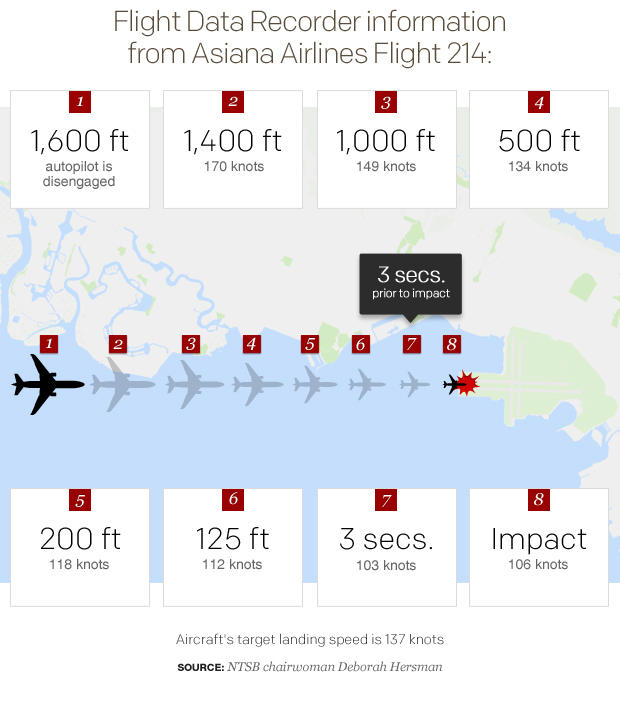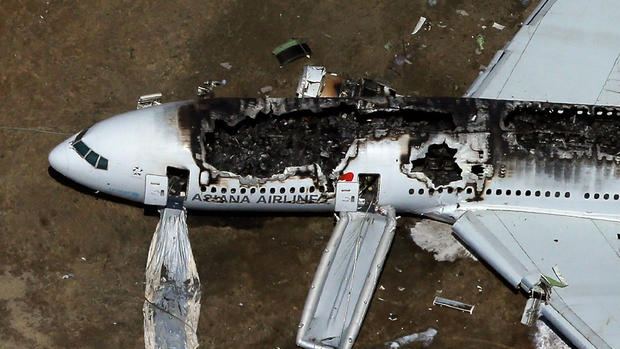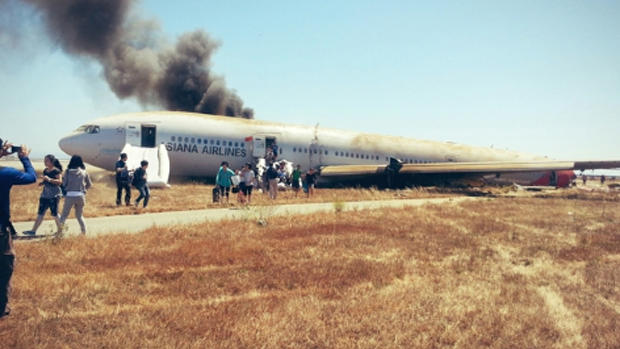NTSB: S.F. jet was far below target speed before crash
Updated 6:30 p.m. ET
SAN FRANCISCO The Asiana Airlines plane that crashed at San Francisco International Airport was traveling at just 106 knots at impact - well short of the 137-knot target speed, federal investigators said on Monday.
National Transportation Safety Board chairwoman Deborah Hersman said the flight data recorder from Flight 214 indicates the pilots disengaged the autopilot 82 seconds prior to the impact. She said that three seconds prior to the crash, Asiana Flight 214 recorded its lowest speed of 103 knots and at impact, the plane's airspeed only reached 106 knots - well below the aircraft's target landing speed of 137 knots, or 157 mph.
- Asiana Airlines: Pilot was getting on-the-job-training
- Asiana Airlines Flight 214 tried to abort landing
- Survivor: Asiana Airlines Flight 214 crew seemed surprised by crash
Despite at least one report that the 777 experienced a rapid descent rate prior to impact, Hersman said the radar data indicated that there was "no abnormally steep descent."
Hersman also said part of the tail section of the Asiana jetliner was found in the waters of San Francisco Bay, and debris from the seawall was carried several hundred feet down the runway, a federal official said Monday.
The lower portion of the plane's tail cone, she also said, was found in rocks inside the seawall. A "significant piece" of the tail of the aircraft was in the water, and other plane parts were visible at low tide.
The plane's location above the San Francisco Bay raises some red flags. CBS News correspondent John Blackstone reported that a normal descent on Runway 28 Left requires an angle that keeps jets well above the waters, but 16 seconds before the crash, the jet was 200 feet above the bay.
In a window seat just behind the wing, passenger Benjamin Levy said started to worry.
"I don't see runway, I just see water," Levy recalled. "So I'm realizing we're way too low, but I'm like, 'oh, he's going to make it, he knows what he's doing, right?'"
Investigators have reviewed airport surveillance video to determine whether an emergency vehicle ran over one of two teenage girls killed in Saturday's crash, Hersman told reporters, but have not been able to reach any conclusions.
She called the possibility that a girl was run over a "very serious issue."
"I can tell you that the two fatalities were located in seats towards the rear of the aircraft. This is an area of the aircraft that was structurally significantly damaged. It's an area where we're seeing a lot of the critical or serious injuries," Hersman said of the girls' location.
Investigators want to make sure they have all the facts before reaching any conclusions, Hersman said, adding that the coroner has not yet determined the girl's cause of death and is charged with doing so.
San Mateo County Coroner Robert Foucrault earlier said his office was conducting an autopsy to determine whether one of the victims survived the crash but was run over and killed by a responding vehicle. He said his staff was notified of the possibility by senior San Francisco Fire Department officials at the crash site on Saturday.
San Francisco Fire Chief Joanne Hayes-White and Assistant Deputy Chief Dale Carnes both said earlier Monday that one of the two teenage girls killed in the crash might have been struck.
"There was a possibility one of two fatalities might have been contacted by one of our apparatus at one point during the incident," Carnes said.
More than 180 people went to hospitals with injuries. But remarkably, 305 of 307 passengers and crew survived the crash and more than a third didn't even require hospitalization. Only a small number were critically injured.
Investigators said the crew tried to abort the landing just before it smashed onto the runway. What they don't yet know is whether the pilot's inexperience with the Boeing 777 and at San Francisco's airport played a role. Officials said the probe will also focus on whether the airport or plane's equipment also could have malfunctioned.
One of the issues NTSB investigators are certain to give a hard look is what role pilot fatigue played in the accident. The accident occurred after a 10-hour nighttime flight. As is typical for long flights, there were four pilots on board precisely so that they can switch off in teams of two to get rest. But pilots who are regularly fly long routes say it's very difficult to get restful sleep on planes.
CBS News aviation and safety analyst Mark Rosenker, a former NTSB chairman, said on "CBS This Morning" that investigators had already made "significant progress" because they have the cockpit recorders, eyewitnesses and they can talk to both crew members and pilots in the vicinity who had a front row seat to the crash landing.
"But there's a long way to go before they can really understand exactly what happened, why it happened and then make recommendations to prevent it from happening again," Rosenker said.
CBS News aviation and safety analyst Capt. Chesley "Sully" Sullenberger said the investigation could take 18 months.
"They're writing a nonfiction detective story that may be 900 pages," Sullenberger said on "CBS This Morning."
Investigators said the weather was unusually fair for foggy San Francisco. The winds were mild, too. During the descent, with their throttles set to idle, the pilots never discussed having any problems with the plane or its positioning until it was too late.
Firefighters said they encountered smoke, leaking jet fuel and passengers coming down on chutes when they arrived. Lt. Christine Emmons said Monday at the news conference that she and her partner ran up a chute into the plane and found four passengers trapped in the back. The conditions in the plane were changing rapidly, with the fire coming down on rescuers and the smoke thickening as the trapped passengers were pulled out to safety, she said.
Seconds before the Boeing 777 struck down, a member of the flight crew made a call to increase the jet's lagging speed, Hersman said Sunday. Then came a warning that the plane was about to stall and cockpit communication that the crew wanted to abort the landing and go back up for another try, she said.
The airline said Monday in Seoul that the pilot at the controls had little experience flying that type of plane and was landing one for the first time at that airport.
Asiana spokeswoman Lee Hyomin said that Lee Gang-guk, who was at the controls, had nearly 10,000 hours flying other planes but only 43 in the 777, a plane she said he still was getting used to flying. Another pilot on the flight, Lee Jeong-min, had about 12,390 hours of flying experience, including 3,220 hours on the 777, according to the Ministry of Land, Infrastructure and Transport in South Korea. Lee was the deputy pilot, tasked with helping Lee Gang-guk get accustomed to the 777, according to Asiana Airlines.
However, Sullenberger cautioned that the total number of hours flying may not be a factor. He pointed out that his first officer on the "Miracle on the Hudson" flight, Jeff Skiles, had never flown an Airbus before the flight - but he had extensive training and had captained many other airplanes.
"Everybody's new on an airplane at some point (in their career)," Sullenberger said.
Two other pilots were aboard, with teams rotating at the controls.
There was no indication in the discussions between the pilots and the air traffic controllers that there were problems with the aircraft.
Survivors and rescuers said it was nothing less than astonishing that nearly everyone survived after a frightful scene of fire burning inside the fuselage, pieces of the aircraft scattered across the runway and people fleeing for their lives.
In the first comments on the crash by a crew member, cabin manager Lee Yoon-hye said that seconds before impact she felt that something was wrong.
"Right before touchdown, I felt like the plane was trying to take off. I was thinking 'what's happening?' and then I felt a bang," Lee told reporters Sunday night in San Francisco. "That bang felt harder than a normal landing. It was a very big shock. Afterward, there was another shock and the plane swayed to the right and to the left."
She said that during the evacuation, two inflatable slides that were supposed to inflate toward the outside instead inflated toward the inside of the plane, hurting two Asiana flight attendants. Pilots came to rescue the flight attendants but even after getting injured, she said that the crew did not leave the plane until after the passengers evacuated. She said she was the last one to go.
South Korea's Ministry of Land, Infrastructure and Transport said the 291 passengers included 141 Chinese, 77 South Koreans, 64 Americans, three Canadians, three Indians, one Japanese, one Vietnamese and one person from France.
The two dead passengers have been identified as students from China - 16 and 17 years old - who were scheduled to attend summer camp in California with dozens of classmates. Hospital officials said Sunday that two of the people who remained hospitalized in critical condition were paralyzed with spinal injuries, while another two showed "road rash" injuries consistent with being dragged.
Foucrault, the coroner, said one of the bodies was found on the tarmac near where the plane's tail broke off when it slammed into the runway. The other was found on the left side of the plane about 30 feet (10 meters) away from where the jetliner came to rest after it skidded down the runway.
The flight originated in Shanghai, China, and stopped over in Seoul, South Korea, before making the nearly 11-hour trip to San Francisco.
When the plane hit the ground, oxygen masks dropped down, said Xu Da, a product manager at an Internet company in Hangzhou, China, who was sitting with his wife and teenage son near the back of the plane. He stood up and saw sparking - perhaps from exposed electrical wires - and a gaping hole through the back of the plane where its galley was torn away along with the tail.
Xu and his family escaped through the opening. Once on the tarmac, they watched the plane catch fire, and firefighters hose it down.
In the chaotic moments after the landing, when baggage was tumbling from the overhead bins onto passengers and people all around her were screaming, Wen Zhang grabbed her 4-year-old son, who hit the seat in front of him and broke his leg.
Spotting a hole at the back of the jumbo jet where the bathroom had been, she carried her boy to safety.
"I had no time to be scared," she said.
Nearby, people who escaped were dousing themselves with water from the bay, possibly to cool burn injuries, authorities said.
By the time the flames were out, much of the top of the fuselage had burned away. The tail section was gone, with pieces of it scattered across the beginning of the runway. One engine was gone, and the other was no longer on the wing.


